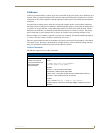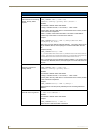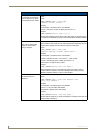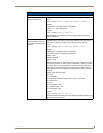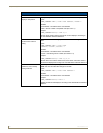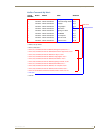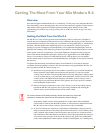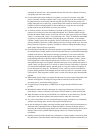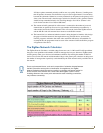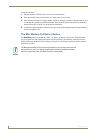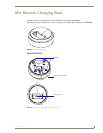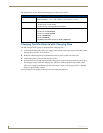
Getting The Most From Your Mio Modero R-4
89
Mio Modero R-4
Getting The Most From Your Mio Modero R-4
Overview
One of the strengths of the Mio Modero R-4 is its flexibility. Not only may a user change the Mio R-4’s
basic functionality, such as changing presets, but it also has the capacity for upgrades to add or improve
other abilities. These upgrades are available by direct uploading of new firmware via the USB
programming jack (see the Using the Programming Jack on the Mio R-4 section on page 31 for more
information).
Getting the Most From the Mio R-4
The Mio R-4 uses a new wireless personal network technology (802.15.4) and protocol (ZigBee) to
transmit and receive information. With the advent of new technologies that surpass previous ones both in
speed and in data transmission, the average user is accustomed to a design philosophy of "smaller, better,
and faster". Because ZigBee and its underlying protocol were designed for a mesh- type network
topology, low power consumption, and interoperability, not for bandwidth, that philosophy cannot be
applied to this technology. WiFi (802.11b/g) products from AMX are wireless Ethernet devices and can
sustain speeds in the tens of megabits per second, while ZigBee was designed for small, low-power
devices with minimal bandwidth requirements. The best way to approach the use of AMX ZigBee
devices is to treat them as if they were AMX AXLink devices. AXLink devices can only handle a
specific amount of data at one time due to bandwidth limitations, and ZigBee devices must be treated in
the same way.
To optimize the functionality and extend the battery life of the Mio R-4, several things should be
considered when programming its interface. (For more information on programming the Mio R-4, see
the Programming the Mio R-4 section on page 31.)
Installations using standard wireless must adhere to precautions, just as in WiFi installations.
Proper placement of the ZigBee network gateway and repeater(s) is critical for reliable
coverage. Just as in WiFi, avoid placing these devices near large metal objects, behind, under,
or on top of metal objects, or any other place where interference could be an issue. Due to the
wireless nature of the ZigBee network, temporary interference (such as leaving a room or
having objects pass between the Mio R-4 and its gateway device) may prevent a command
from reaching the NetLinx master.
Because of temporary interference issues (such as leaving a room or large objects passing
between the Mio R-4 and its gateway device) preventing commands from reaching the
NetLinx master, special attention must be paid to volume control.
Programmers should consider setting safeguards for volume control (either established
volume limits or timeouts with the NetLinx master, or more interactive adjustment from the
Mio R-4 such as direct volume control) to prevent issues with lost commands.
To avoid a frustrating user experience, a programmer's understanding of the type of device
being used and the amount of data being sent to and from the device is crucial. While a touch
panel can handle large amounts of data for functions such as list boxes, variable text fields,
and commands to alter button behavior, the Mio R-4 cannot. The programmer must always be
aware of how many messages will be sent to the remote for any given event (online/offline
events, button push/release, channel updates, variable text field updates, etc.). Sending many
If a remote command is lost while increasing volume, the master may receive the
command to increase the volume but not the command to stop increasing it.



